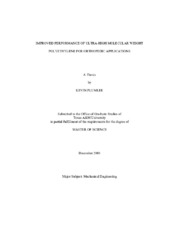| dc.description.abstract | A considerable number of total-joint replacement devices used in orthopedic
medicine involve articulation between a metallic alloy and ultra-high molecular weight
polyethylene (UHMWPE). Though this polymer has excellent wear resistance, the wear
particulate produced leads to the limited lifetime of the devices – osteolytic bone loss.
Crosslinking has been shown to reduce the wear rate of UHMWPE, but can cause a
reduction in various mechanical properties such as impact toughness. This study
presents two alternate approaches to improving the wear performance of UHMWPE in
orthopedic applications
Previous work has shown that UHMWPE-based composites have wear resistance
comparable to the irradiation-crosslinked polymer. Zirconium has been shown to have
excellent corrosion resistance and biocompatibility, and the authors have used the
material as reinforcing filler in UHMWPE with promising results. Compression-molded
UHMWPE composites with up to 20 weight percent (wt%) of micro-sized zirconium
particles were investigated with regards to wear behavior and impact toughness. These composites showed a significant reduction in wear compared to unfilled polymer while
still maintaining impact toughness. These results reinforce the paradigm of using
polymer composites for orthopedic applications and may provide a viable alternative to
the property tradeoffs encountered with irradiation crosslinking.
Apart from UHMWPE, novel materials including hydrogels and bio-derived
polymers show great potential in orthopedics, but such materials require the
development of innovative fixation techniques [1-3]. The development of controlled
porous UHMWPE morphologies offers the opportunity to utilize and expand these
developing technologies. Interconnected porous structures were prepared by dry
mechanical mixing of NaCl particles and UHMWPE powders followed by compression
molding. Samples were soaked in water to remove the embedded salt, leaving a porous
UHMWPE structure. Computational simulations of porogen distribution and leaching
predicted leaching to be 95% effective when initial salt concentrations were 60wt% and
higher, which was found to match very well with the experimental data. It was found
that varying the concentration and particle size of the porogen can tailor the final pore
morphology to a specific application, while DMA results showed that storage and loss
moduli depend greatly on porosity, but not on pore size. Finally, porous UHMWPE
scaffolds were successfully impregnated with gelatin, confirming the compatibility of
UHMWPE with hydrogel-based fillers. | en |


